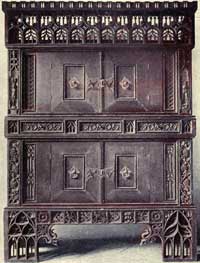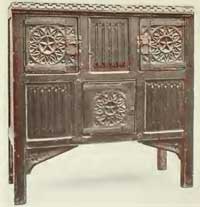Gothic Furniture
The Gothic furniture, when compared to the other European furniture styles, is covering the longest period. The Gothic period proper lasted from the 12th to the 15th century, while its characteristic ornaments survived side by side with the new influences up to the beginning of the 17th century. The Gothic furniture style even had its own Renaissance with the Gothic revival of the 19th century.
The furniture of the Gothic period, with its characteristic contour and ornaments, derived from the Gothic Art which originated in France at the beginning of the 12th century. In its early stages, the furniture was quite simple, than it evolved towards an architectural character. The decorations were done by painting and, later, mainly carving, with tracery as principal element.
The Gothic period furniture, similar to the Gothic architecture, had local particularities, one of them being the wood used for its construction. In England, Germany, and the Low Countries it was mainly oak, in France, chestnut, in Italy and Spain walnut.

Gothic Furniture Press, German, about 1500
The carving had almost a geometrical character. The chief ornamentation motifs, imported from architecture, were the pointed arch, the trefoil and quatrefoil, the wheel, the rose, and the linen-fold.
Gothic style chests and armoires
Early chests were of simple, robust construction, decorated only with ornamental hinges. Initially, they were used exclusively for travel. Later in the period, as the chests grew larger and heavier, they became static, elaborately carved pieces of furniture, and main components of the Gothic interior decor.
The armoire became the main piece of the domestic Gothic interior. It was more luxurious than any other piece in residences of all classes. Variations like cupboards, cabinets, French armoires and buffets, all were in use during the Gothic period.
Gothic chairs
Chairs were scarce, and were associated with a sense of state majesty, being used only by the masters. In each room of the residences of the period, there was only a chair, that of the feudal lord, while persons of lower ranks were using benches, or chests. In the 12th century, chairs could be rectangular or circular, with low backs. In the 13th century, the seats of the lords’ chairs of honor had a polygonal shape. Chairs became heavier and larger, and in the 14th century they were built with canopies, becoming similar to the royal thrones.
It should be noted that, outside the castles, the chairs, although still richly carved, were lighter, and more closely resembling the modern furniture.
Gothic furniture beds and tables
Starting with the 12th century, the beds became more luxurious. They evolved to massive, richly carved four posted pieces, decorated with expensive embroidered fabrics. They had refined ornaments, carved or painted, and were draped by hangings, with or without a canopy.
In the 14th century, more attention was given to the precious fabrics adorning the beds, with the wooden parts being partly hidden from view, except the carved bed head, which became higher.
The early Gothic furniture tables were simple, rectangular trestle-tables, usually long and narrow. Latter, they were replaced by more elaborated, ornamented pieces. In the great hall of the castles, there were also monumental stone or marble tables.

